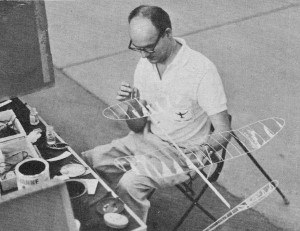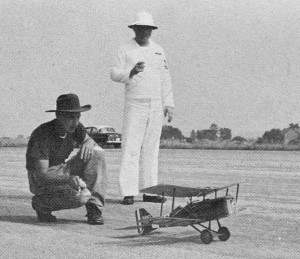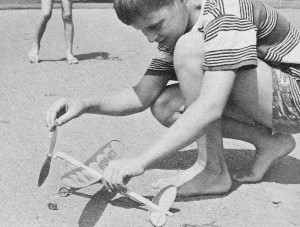|
An
extensive article introducing non-modelers to aircraft modeling
appeared in the Annual Edition of the 1962 American Modeler magazine.
15 pages were devoted to describing just about every aspect of model
building and flying - free flight gas and rubber; control line stunt,
combat, scale, and speed; helicopters and ornithopters; indoor gliders,
stick and tissue, and microfilm; even some early radio control.
In order to keep page length here reasonable (because of all
the images), the article is broken into a few pages. Pages:
|
10 & 11 |
12|
13 |
14 |
15 |16
|
17 |
18 |
19 |
20 |
21 |
22 |23
|
24 | For Non-Modelers: All About Air Modeling
20 Easy Ways to Go Crazy! <previous> <next>

Top-notch indoor endurance planes look much alike; 30" span
entry by Thermal Thumber Andrew Faykun is typical. Fragile microfilm-covered
rubber powered jobs present problem to transport. This weighs
5/100-oz.

World War One starts takeoff roll in gas powered free flight
scale event. Rough cement runways are tough on tiny scale-size
wheels

Durable rubber-powered ready-to-go rise-off-ground (ROG) craft
is the AJ Hornet. Models not much different flown long before
first real plane.
Once rudder-only model flying and radio operation are mastered the
modeler can progress to R/C systems with more controls. Shortest
step up is to the compound escapement or servo motor giving one
or two additional controls with some added expense and complication.
Elevator control or engine throttle add punch to the variety of
flight control possible with even the smaller sport or trainer models.
Tops in R/C model flying are the "full-house" systems utilizing
multi-channel receivers capable of operating ALL the control functions
of the model simultaneously. This is the "most":. Rudder (with steerable
nose or tail wheel), trimmable elevator, ailerons, engine throttle
and even wheel brakes give the R/C flyer as complete control of
the model as a pilot has over a real aircraft. Such R/C models are
large with 6 ft. plus wing spans and .35 to .60 cu. in. engines.
Size is necessary to carry the payload of several pounds of radio
equipment. Prominent designs are high-wing, low wing and shoulder
wing. Uncountable hours of building, tuning, trimming and
maintenance go into the flying of this the ultimate in modeling.
The flight performance is worth every minute and dollar spent, according
to R/C's most enthusiastic super-modelers. A typical flight
must be seen to be believed. It can be described thus: After assembling
and fueling the model, the flyer starts the engine. Radio is turned
on and all control actions are checked off. With engine idling,
model is taxied to take-off spot controlled by brakes, rudder and/or
wheel. Squared away into the wind, throttle is opened and model
starts its take off. Airborne, climb is maintained to a safe altitude.
The model is then throttled back and guided through a variety of
flat pattern maneuvers such as S-turns. figure eights or rectangles.
Adding throttle once again model is climbed higher where loops,
rolls, Cuban eights and spins can be done using all flight controls
and throttle settings. With throttle retarded model descends and
landing approach pattern is begun. Elevator and throttle controls
are used to accomplish a real three-point landing. Model is then
taxied back to the flyer and stopped with the brakes. He reaches
down, cuts engine and turns off radio -- Fantastic! Is it any wonder
such model flying has such a tremendous appeal? Radio control
flying competition is the apex of all modeling and a very high caliber
of performance is exhibited. As the A.M.A. rule book so aptly states:
"The criterion is the quality of the performance, not the mechanism
of control. R/C competition is based on the excellence of performance
of the model's maneuvers, compared to similar maneuvers performed
by a futt-slzed plane." R/C contest flying is divided into
three classes: "Rudder-class." models with rudder-only control;
"Multi-class," models with systems allowing independent operation
of any and all control surfaces; "Intermediate." models which do
not fall into rudder or multi-classes. Model is scored while
performing the Pattern event maneuvers. The list is long and includes
the flat pattern maneuvers described above and many other stunts
done at altitude. Another very interesting phase of R/C
contest flying is Pylon Racing. Here flat-out speed around a 1/10
mile long two pylon course is the criterion. As in other phases
of modeling Pylon racing has developed a specialized design type
somewhat different from general R/C designers. Models feature long.
slender fuselage. thinner than usual airfoils with high and shoulder
wings predominating. Engines up to 20 cu. in. sizes are permitted
with definite wing area limits for various engine sizes. Speeds
have climbed to over 44 mph in pylon racing and similar models fitted
with .60 engines have upped straight-away world FAI speed record
to 110 plus mph.
Third
phase of R/C contest flying is Flying Scale already covered in preceding
section on Scale. INDOOR - Unquestionably
the most unusual. far-out, weird and wonderful phase of all model
building and flying is Indoor. This is a separate little model world
remote in its extremes from all other types of modeling.
First of all there are only three sites in the U.S.A. where
major indoor contest flying is conducted. These are the large airship
or blimp hangars (docks) at South Weymouth. Mass, Lakehurst, N.J..
and Santa Ana. Calif. In addition to these locations, indoor model
flying can also be done in the many large armories, convention halls
and auditoriums in other cities throughout the country although
the heights of the ceilings limit performance. <previous> <next>
Posted December 25, 2010
|



